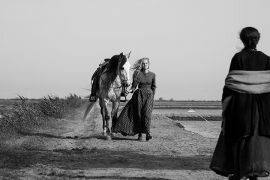Camilo Restrepo’s film is immersive and intense. It is also subtle, sublime, at times soporific. It’s a challenging watch and so dense that its 70 minutes feel like two hours. It is hardly entertaining but that’s not to say it’s a bad work: if you manage to watch closely you will find yourself rewarded.
That’s partially due to the fact that Los conductos is barely a narrative film but has more similarities to a short film or a film essay. It is not told in a chronological way and doesn’t form a cohesive story, yet we know the following: the narrator and main character Pinky is a seedy character, roaming the underbelly of Bogotá. He is a guard of some type of factory, a worker in a printery, he is seen buying and consuming drugs, wielding a gun, stealing copper and selling fake Adidas and Kappa shirts. Occasionally, Pinky runs into other characters, such as Revenge who claims not to have any need for anything to survive.
Los conductos works mainly as a visual feast. The narration is sparse and is mostly handled by Pinky, in philosophical discourse or in stories, told as if sitting around a campfire. Other tales have a political motivation and speak of a Colombia that should start treating its children better. Yet, as a whole Restrepo’s movie is not a political one. If it’s possible to even sum it up, one could call it an elegy on the underground, a survey of the nighttime.
It’s shot on gorgeous 16mm film, grainy and deep and has the distinct look of a movie that could have been released somewhere in the 60s or 70s. The camera movement and editing are often hypnotic, Restrepo’s direction is very reduced but assured. At times the screen is filled out by impenetrable blackness that only gradually gives way to a slab of light on a staircase or a wall. It’s a testament how well Restrepo handles his material that we always know where we are.
Take one of the first scenes that illustrates Pinky robbing a motorcycle: a bullet hole turns to a red gas tank, cut to Pinky’s face in the bushes, cut to his hand picking up a stone, cut to a beige surface up close, sounds of something knocked off, sound of a motorcycle revving and speeding off. We follow Pinky into abandoned warehouses, trash heaps, into the jungle, we watch molten metals in a forge as Pinky speaks of the magma beneath Colombia’s surface.
Another memorable excourse tells the tale of potholes in the streets and politicians trying their best to cover these potholes up, but the potholes come back stronger, they grow, swallow whole cars and lead to another highway, just beneath the upper highway. In one of the last shots, Pinky and Revenge are riding a motorcycle on this subterranean motorway. They are dressed in white, their faces are doused in white, they are the Colombia of yesterday, they are Colombia of tomorrow. It’s an exhilarating ride.




